Ned Kelly is a name that may not be that familiar to those outside of Australia, but thanks to director Justin Kurzel, screenwriter Shaun Grant, and an A-list cast, you’re about to be. Some may have been fortunate enough in school to get an inkling of who Ned Kelly and the Kelly Gang were, but not on any large scale beyond Australia. A legend in his own right, Kelly is to Australia what Davy Crockett, Daniel Boone, Paul Bunyan, and others are to the United States, William Tell to Switzerland, and Robin Hood to England; a larger than life individual whose real life adventures and exploits grew into a mythology that is cherished and celebrated.
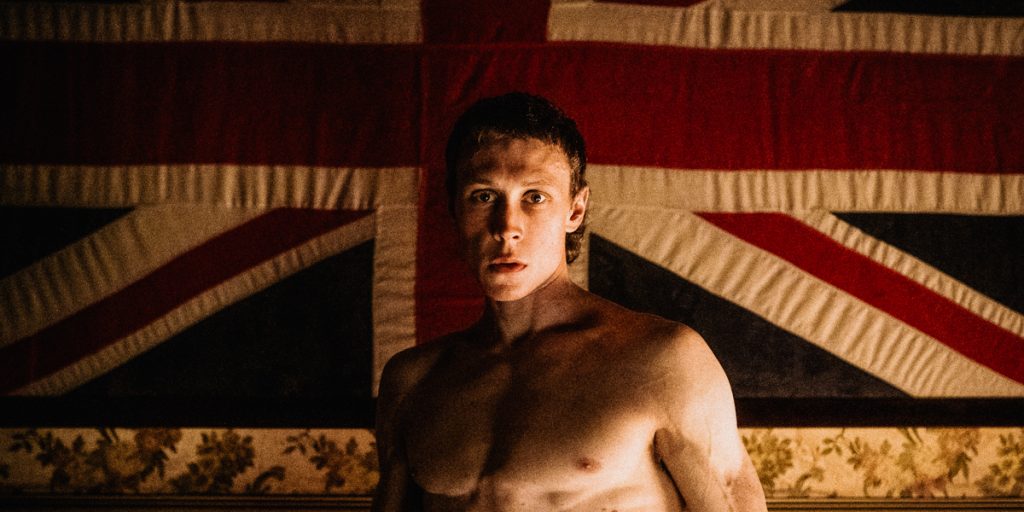
Kelly was an Australian bushranger who, while a young teen, came under the tutelage of Harry Power, before ultimately rising to his own claim to fame as an outlaw, gang leader, and cop-killer known for leaving a swath of visceral, bloody carnage. Perhaps one of the greatest legends about Kelly was his obsession with the USS Monitor. Built during the Civil War, the Monitor was the first iron-hulled, steam-powered, ironclad warship of the US Navy. Believing himself to be as invincible as the Monitor, Kelly fashioned himself a full-body suit of bulletproof armor which he wore in his final shootout with the police in Victoria.

While there have been some iterations of Ned Kelly’s story on the big and small screen as well as on the printed page, none compares with what Kurzel delivers now with the TRUE HISTORY OF THE KELLY GANG. What a story! What a film! Engrossing! Fascinating! Heartpounding! Commanding!
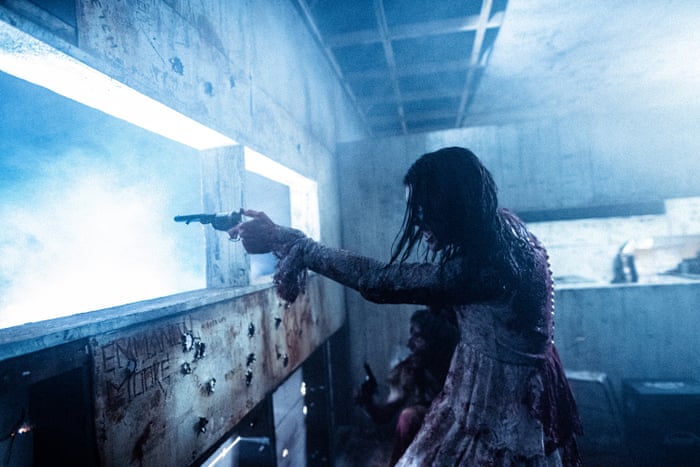
Riveting from beginning to end, the film is constructed as if an “autobiography” being told by Kelly himself, the style with which Peter Carey wrote the novel on which this film is based. While historical license is taken with Ned Kelly’s life, his actual exploits were so infamous that it feels as if some adventures were tamed for the film while in other cases literary license was taken. Starting with Kelly’s childhood and strong matriarchal influence (to the point of being detrimental to him as he grew up), setting the tone of the film is bookending with a voiceover of Ned Kelly, perfectly played by George MacKay, speaking his memoirs to be given to his daughter in the future. As he did in real life, Kelly’s documenting his life on paper was something he learned from Harry Power and religiously did so people would know the “truth” about him. With this structure in place, we are taken through Kelly’s life in reflective chronological order with an intensely visceral and enlightening character study of rebellion and the challenging of authority while taking charge of one’s own destiny as Kelly goes from being a young boy becoming the man of the family to his death by hanging. Striking is the depth of emotion and the internal conflict which we see and feel within Kelly thanks to MacKay’s indelible performance.
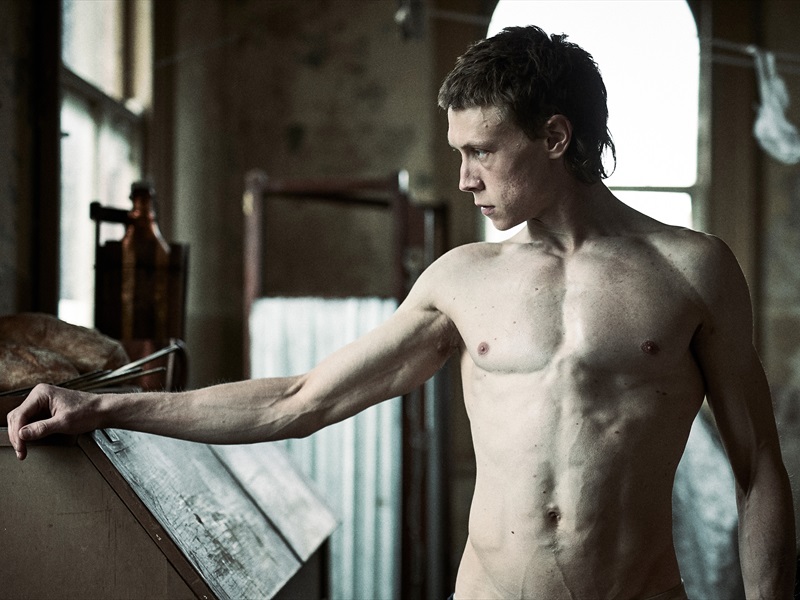
While Kelly intersected with many individuals over the course of his life, Kurzel and Grant wisely focused on limiting the number of three-dimensional and tapestried characters to those directly key to Ned Kelly’s life. Chaptered as Boy, Man, Monitor, stages of Kelly’s life are transitioned with vibrant telling graphics that have almost a steampunk feel to them. Following through on this sensibility, we see a nice blend of the 1870’s period laced with nods to a more modern punk concept. Watching this film, it may be safe to say that Ned Kelly would have fit quite nicely in the punk world of the 20th and 21st centuries.
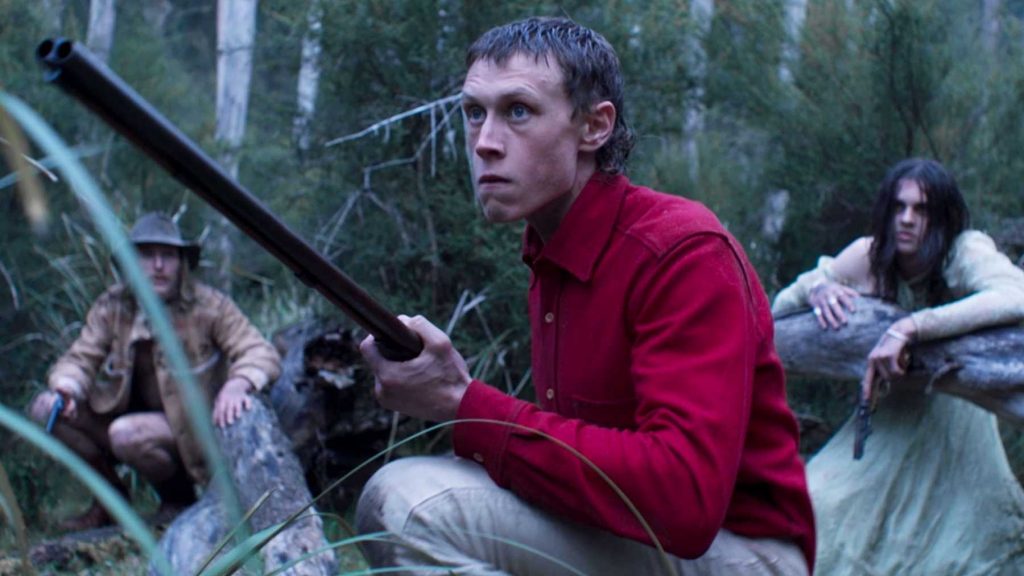
TRUE HISTORY OF THE KELLY GANG is a study in contrasting darkness and light, both visually and emotionally, as it defines a man and his life. Achieving an effective tonal balance, the exemplary production values bring the film to life and complement powerful performances.

As we saw with 1917, this IS George MacKay’s film. He once again shows that he has come into his own as a leading man, a leading character in a film. Interesting is that even as a character in a “leadership” position, MacKay maintains a level of insecurity that comes to the surface through small physical tics, notably when he doesn’t look someone in the eye and glances downward like a child. That works so well in helping to define Kelly at his heart. While Ned remains defiant and “a man” once he kills a cow and brings a leg of beef home for dinner, for the remainder of the film he is strong, back straight, firm posture, and looks straight ahead – unless he is embarrassed or shamed. Fascinating to watch MacKay vacillate between scenes with Thomasin McKenzie as Ned’s true love Mary to scenes with Essie Davis to going toe-to-toe with Nicholas Hoult’s Constable Fitzpatrick. There is a different emotional tone with not only each scene but each interaction. It’s a testament to MacKay’s skillset to watch this unfold.
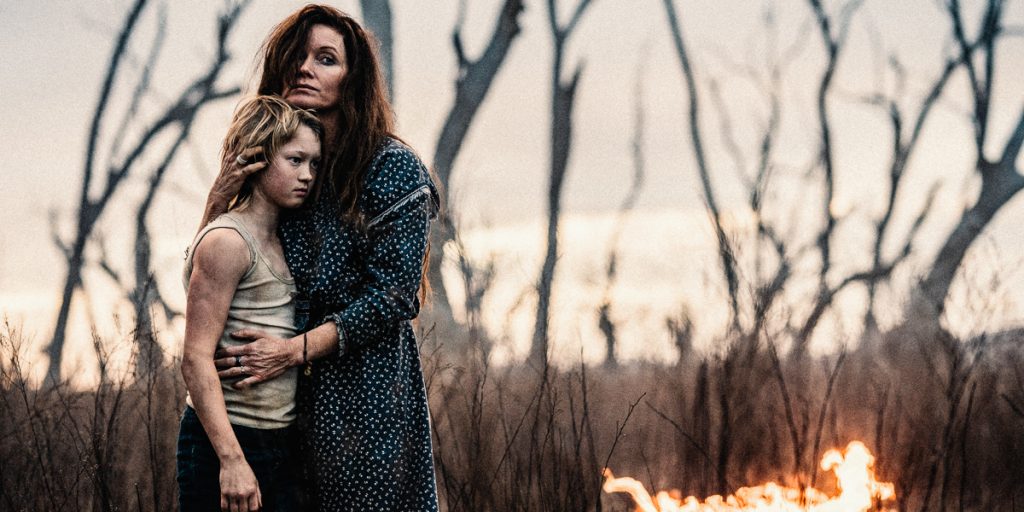
As Ned’s mother Ellen, Essie Davis is flawless. What a performance! Speaks volumes as to the psychological dynamic of the relationship between Ned and his mother. As Mary, Thomasin McKenzie is the one element of softness and sensitivity in the film and in Ned’s life. Lit and lensed with almost a “cheesecloth” effect, the tenderness and innocence McKenzie infuses into Mary perfectly complements MacKay’s Ned.

Perhaps the greatest discovery of this film is young Orlando Schwerdt who plays a young Ned Kelly. He is an absolute scene-stealer and never moreso than when paired with Russell Crowe. A total newcomer, Schwerdt goes toe-to-toe with Crowe physically and emotionally. This is a “wow” performance. Speaking of Crowe. . .Harry Power is a fascinating character and Crowe’s performance is mesmerizing; dare I say, award-worthy as a supporting actor. This is a role tailor-made for him. He gives Power emotional layers, and layers of truth, akin to the layers of clothes he wears, shedding layers of clothes and emotion as he moves through his journey with young Ned. Be on the lookout for a shocking scene with Schwerdt, Crowe, and a naked Charlie Hunnam! Schwerdt doesn’t say but one line, but it’s the fear and then defiance and anger that he brings to the fray that knocks you over and shows us who Ned Kelly is about to become. And yes, Hunnam is fun to see in anything.

Already an admirer of the work of cinematographer, Ari Wegner, thanks to Lady Macbeth and In Fabric, he outdoes himself with TRUE HISTORY OF THE KELLY GANG. Talk about giving a rich, lush look to the burned-out brush wasteland! From the charcoal starkness of black burned groves of trees and ash-grey ground to the soft beauty of a house of ill repute to the wealthy rich reds of an upper-crust inn in which young Ned and Harry stay at one point in their journeys, to the warmth and softness of the Kelly “home” in the evenings at dinner, to the use of firelight and candles throughout the film, to the saturated sepia-toned poverty of the land, with all draped in the intensity of blood-soaked madness and mayhem, and a strobe-lit third act shoot-out sequence punctuated by Kelly’s hanging, the result is compelling, shocking, and heart-wrenching. Use of color, contrast, and saturation is electrifying. And then we turn to the action.

Action sequences are extremely well executed. Violence and carnage are beyond visceral and not for the faint of heart. There is so much violence, in fact, that some of it could have easily been pared down a bit. I do take issue, however, with many of the blood effects as they are so saturated, it looks as if cans of paint were just thrown on people or they dunked their hands into the paint cans. The color red, especially in the third act, is disturbing in that it is so far from anything that resembles human blood, no matter whether an artery or vein or capillary traveling to or from the heart, that it becomes distracting.
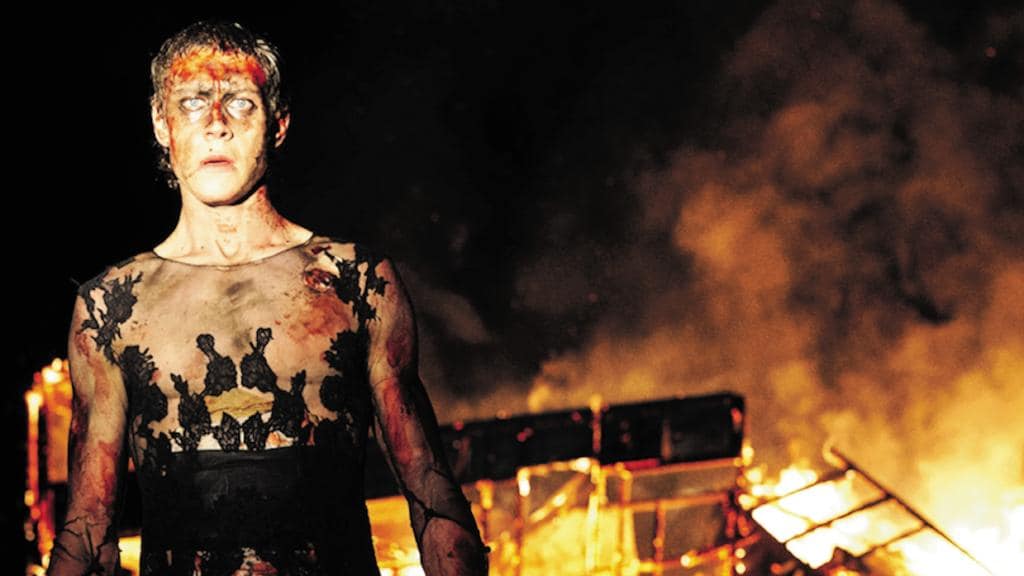
Where Wegner’s lens truly excels, however, is capturing faces. The faces of the actors in this film are gritty, life-worn, and the eyes speak volumes. ECUs of MacKay shout and scream from behind a stoic surface calm. And the framing and lensing of Essie Davis as Ned’s mother is beyond telling. We see her loyalties and manipulations in each moment of the film due in large part to framing and whom she is favoring in the frame. It’s fascinating to watch. There is nothing but softness and beauty whenever Thomasin McKenzie is onscreen (a lovely white lace dress costumer Alice Babidge puts her in defines Mary). This is award-worthy work by Wegner and could bring him his first Oscar nomination.

Hand in hand with Wegner’s work is that of production designer Karen Murphy who creates a world that is palpable, sensory, tactile. No detail is too small. Her use of color and texture steep us in the period and in the world of Ned Kelly. Beautiful work. The minutia of the detail in the Kelly hut with candles, twinkle lighting and sheer chiffon curtains, as well as the set dress with little knick-knacks and “priceless” items undoubtedly scavenged from the dirt is just one telling example of Murphy’s work. Then add costume designer Alice Babidge to the mix. Such an eclectic blend of looks throughout this film. Perhaps the most telling look, however, comes with the design and costuming of Russell Crowe whose character of Harry Power was really a bridge between the worlds of poverty and wealth.

Finding that sweet spot between light and dark with the film’s pacing is the work of editor Nick Fenton. Crisp, clean, and rapier. Particularly notable is the third act and the final shootout between Kelly and the police. With total darkness but for rapid-fire strobe lights, intense scoring and gunfire, Fenton’s editing bring it all together with perfect cadence.
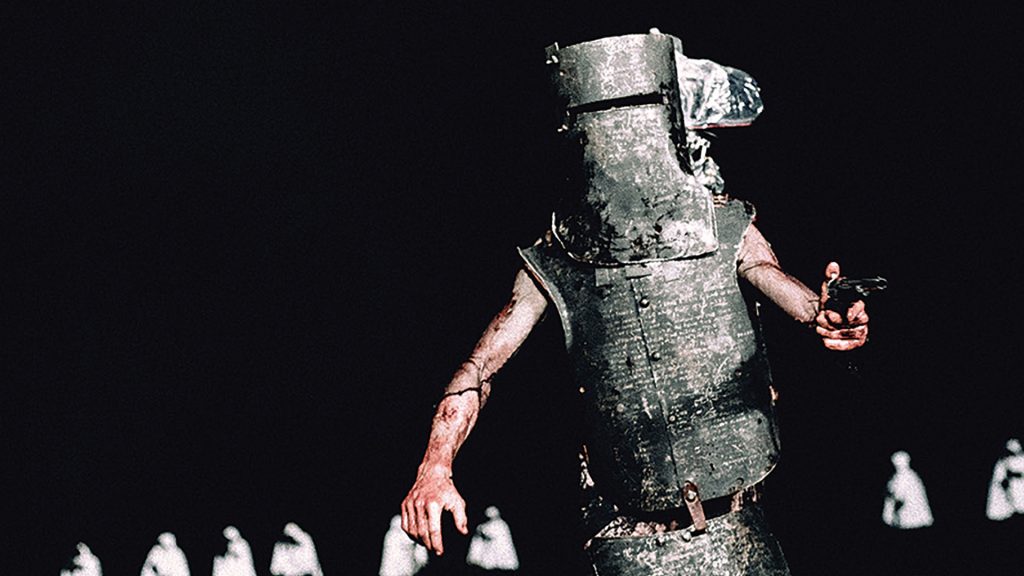
Very impressive is Andrew Neil’s sound design and mix, particularly when Jed Kurzel’s score gets heavier and the action gets more intense. Not to be overlooked or under-appreciated are moments of dead silence, such as with the hanging. There is no sound but for the snap of Ned’s neck which is not only loud but has a slight resonance in the stone-walled empty hollow halls of prison.
Rounding out the full effect of the TRUE HISTORY OF THE KELLY GANG is Jed Kurzel’s score and eclectic selection of heart-pounding, raging, pulsating needle drops.
Directed by Justin Kurzel
Written by Shaun Grant based on the novel by Peter Carey
Cast: George MacKay, Russell Crowe, Essie Davis, Charlie Hunnam, Nicholas Hoult, Thomasin McKenzie, Orlando Schwerdt
Available On Demand and Digital April 24, 2020. The film will also be playing exclusively in LA on the big screen at the Mission Tiki 4 Drive-In in Montclair.
by debbie elias, 04/03/2020












